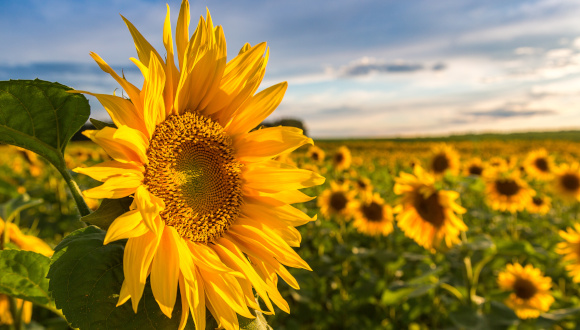Sunflowers “dance” to keep each other in the shade

TAU research sheds light on a biological puzzle
Support this researchA new study by Tel Aviv University (TAU) in collaboration with the University of Colorado, Boulder, found that plants that grow in dense environments, where each plant casts a shadow on its neighbor, find a collective solution to help them discover optimal growth directions with the help of random movements. The research sheds light on a scientific puzzle that has occupied researchers since Darwin.
The research was conducted under the leadership of Professor Yasmine Meroz from the School of Plant Sciences and Food Security at TAU’s George S. Wise Faculty of Life Sciences in collaboration with Professor Orit Peleg from the University of Colorado, Boulder. The research team included Dr. Chantal Nguyen at Boulder and Roni Kempinski and Imri Dromi at TAU. The research was published on August 15, 2024, in the journal Physical Review X.
“Previous studies have shown that if sunflowers are densely planted in a field where they shade each other they grow in a zigzag pattern — one forward and one back — so as not to be in each other’s shadow,” Professor Meroz explains. “This way they grow side by side to maximize illumination from the sun and, therefore, photosynthesis on a collective level.
“In fact, plants know how to distinguish between the shadow of a building and the green shadow of a leaf. If they sense the shadow of a building they usually don’t change their growth direction, because they ‘know’ that will have no effect. But if they sense the shadow of a plant, they will grow in a direction away from the shadow.”
The researchers examined the question of how sunflowers “know” to grow in an optimal way to maximize capture of sunlight for the collective. They also analyzed the growth dynamics of the sunflowers in the laboratory, where they exhibit a zig-zag pattern.
Professor Meroz and her team grew sunflowers in a high density environment and photographed them during growth, taking pictures every few minutes. The photographs were then combined to create a time-lapse movie. By following the movement of each individual sunflower, the researchers observed that the flowers were “dancing” a lot.
Charles Darwin was the first to recognize that all plants grow while exhibiting a kind of cyclical movement, the researchers say. Both stems and roots show this behavior. But before this study it was not clear whether it was a mere artifact or a critical feature of growth. Why would a plant invest energy to grow in random directions?
“As part of our research, we conducted a physical analysis that captured the behavior of each sunflower within the sunflower collective, and we saw that the sunflowers ‘dance’ to find the best angle so each flower would not block the sunlight of their neighbor,” Professor Meroz says. “We quantified this movement statistically and showed through computer simulations that these random movements are used collectively to minimize the amount of shadow.
“The sunflower plant takes advantage of the fact that it can use both small and slow steps as well as large and fast ones to find the optimum arrangement for the collective. That is, if the range of steps was smaller or larger the arrangement would result in more mutual shading and less photosynthesis. This is somewhat like a crowded dance party, where individuals dance around to get more space: if they move too much they will interfere with the other dancers, but if they move too little the crowding problem will not be solved, as it will be very crowded in one corner of the square and empty on the other side.
“Sunflowers show a similar communication dynamic — a combination of response to the shade of neighboring plants, along with random movements regardless of external stimuli,” Professor Meroz concludes.